Penang Pt 1: A Food-Lover's Paradise
On seeing, eating, and exploring Penang's Chinese culture
Hello and welcome back to our newsletter! After 48 very full hours in K.L., we jumped on a plane to head to the state of Penang to continue our indulgent foodventures. Being budget travelers, we opted to fly on AirAsia, one of biggest low-cost carriers in this region. One of the perks of this airline is that they play music as you board and deplane, so we got exposed to a cool Malay artist! Here is the song we heard on every AirAsia flight, in case you’re interested in broadening your musical horizons.
George Town: State and Gastronomical Capital
George Town is the capital of the state of Penang, an island located off the northwestern coast of Malaysia near its border with Thailand. Penang, and George Town in particular, is ethnically diverse and rich in cultural (and gastronomic) heritage. The city itself was established by a British colonialist, but it is a historically Chinese city, with Chinese people making up more than 57% of the population.
Due to the heavy Chinese influence, it is no surprise that Mandarin and Hokkien are among the major languages in the area in addition to Malay, English, and Tamil. In fact, there is even a local variation called Penang Hokkien that serves as a lingua franca for communication between the many ethnic groups!
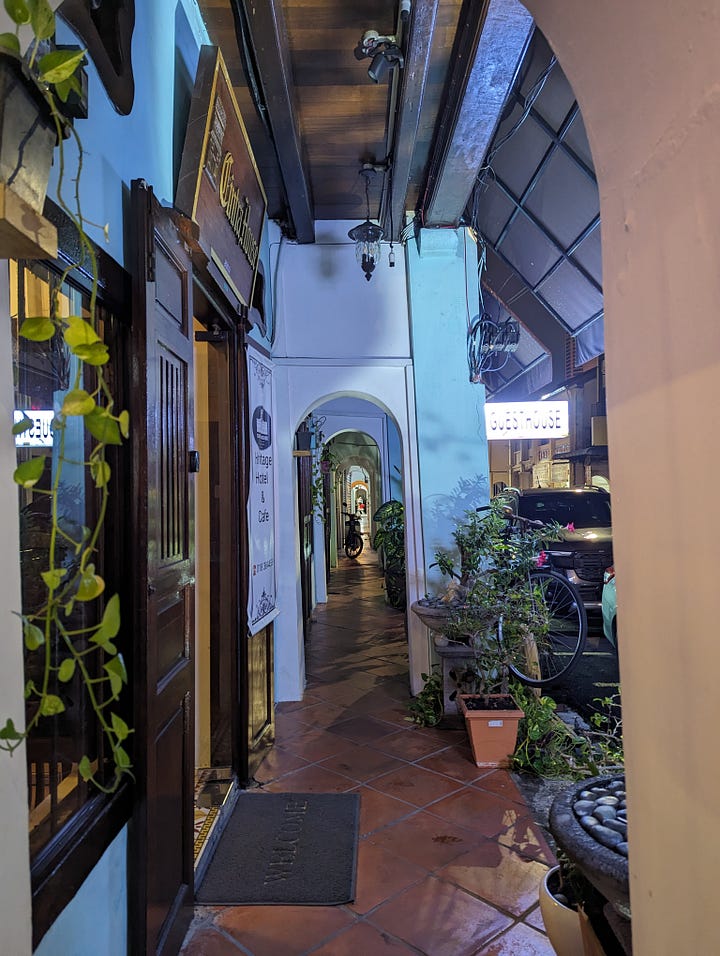
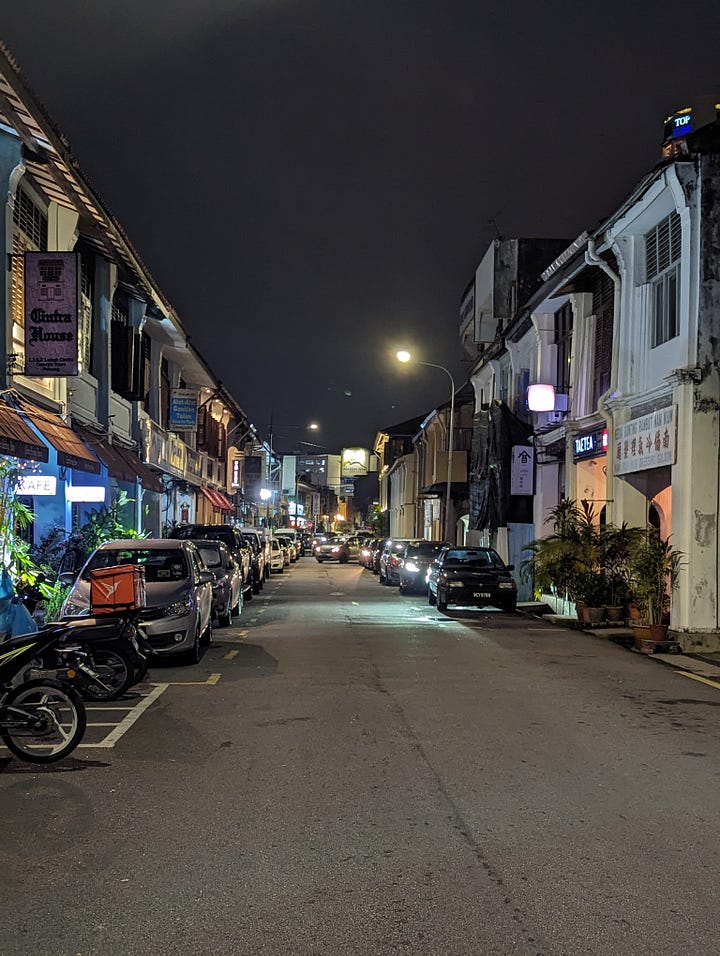
During our time here, we adoring walking around and taking in George Town’s historic architecture. Due to the heavy British influence during their colonization, the Sino-Portuguese architecture in this city reflects the blend of European, Chinese, and indigenous influence the city houses. Walkways throughout the city are covered, providing shelter from the blistering sun and heavy monsoon rains, while archways divide shopfronts and create an inviting feel to continue walking forward. Surprisingly, we seldom saw any traffic.
The Eating Commences: Dang-Huy’s Delicious Dinner
Being a diligent foodie, Malay-food-lover, and cook, Dang-Huy had done significant research into where to dine prior to arriving in Penang. Tonight’s meal would be at Teksen, a famous Chinese restaurant popular with tourists and locals. But before we Grabbed a ride over, Sol ordered some vegan delivery to ensure she was well-fed for the night! With the US dollar being so strong in Malaysia, she decided to get a spread of foods to last her for dinner, breakfast, and snacks.
Sol: It was a really delicious spread that hit the spot! I can’t remember the exact flavors of this meal but the Rendang Curry was my favorite.
Once Sol finished eating, we Grabbed over to Teksen Restaurant at around 6:00pm, expecting it to have just opened so that we wouldn’t have to wait. We stepped out of the vehicle and walked down a quaint but busy pedestrian road filled with aunties selling freshly cut fruit. To our surprise, we saw a huge line of people and a completely full restaurant! Lesson learned - Google Maps information is often not accurate in South-East Asia. Well, nothing to do but settle in to the wait. It was about 30-45 minutes in line, but we were handed menus so that we’d be ready to order once we sat down. Mama-nim and Baba-nim even had enough time to go for a walk while we held down the line!
As we made it closer and closer to the front of the line, we were able to get a better sneak-peek into the restaurant. The sounds of clinking glass and ceramic plateware being stacked, the gemütlichkeit (cozy friendliness) as diners sat around round tables helped themselves and others to a variety of delicious family-style dishes, and the waiters, bussers, and cashiers doing their best to hold down the fort, like managed chaos; we absorbed these new sensations and looked forward with apprehension and hunger.
Finally, we were seated towards the front of the restaurant near the windows and placed our orders. We ordered their homemade fried tofu with shrimp, twice fried pork, kangkong (water spinach), bitter melon with salted duck egg, pork, and prawns, and sweet potato leaf stir fried with prawns.
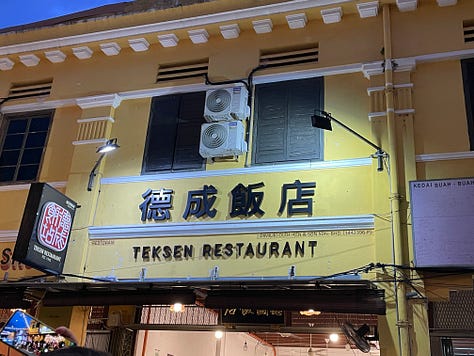

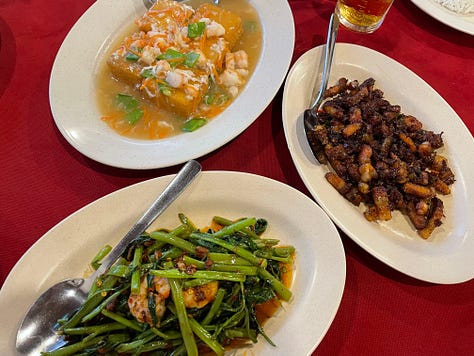

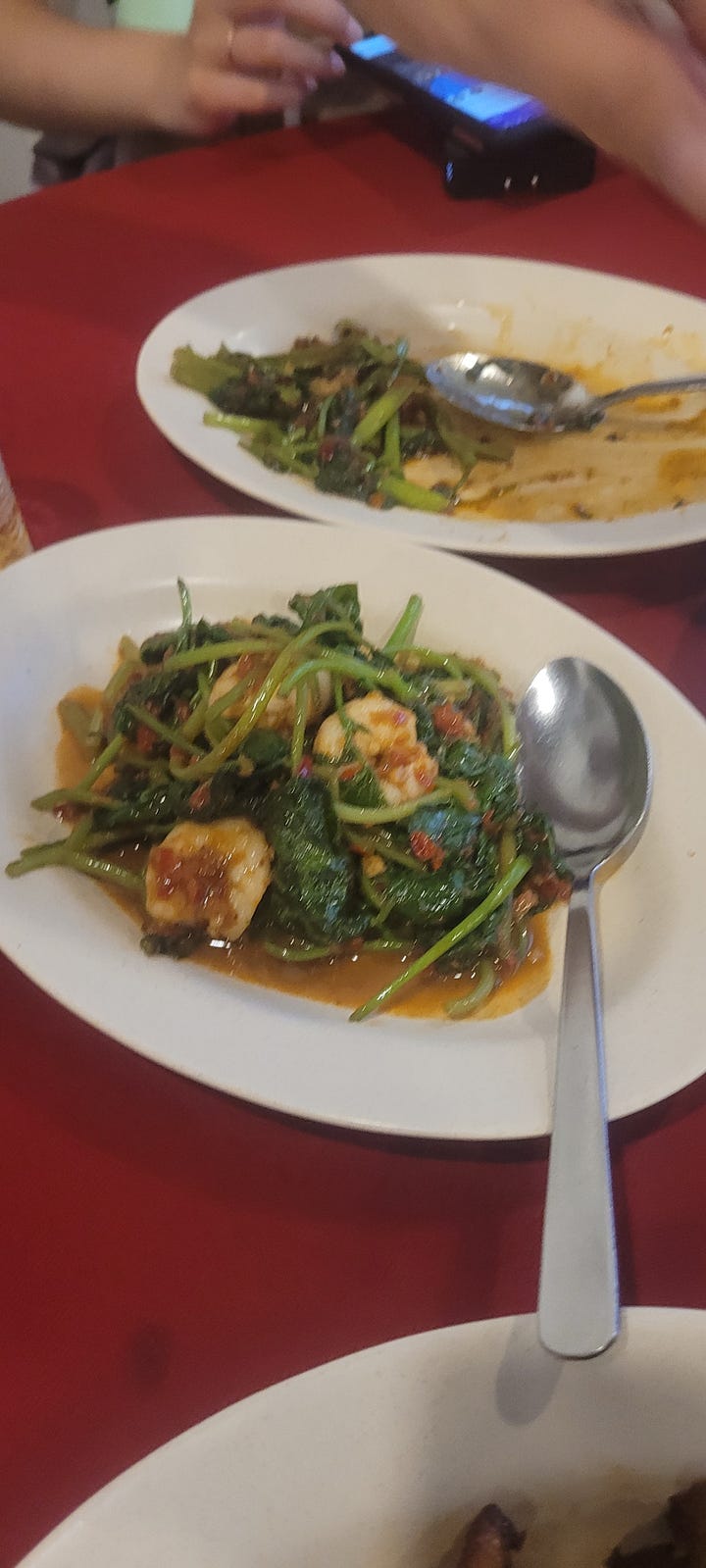
Every item came out steaming on white ceramic plates with serving utensils, and each was an absolute delight. The natural flavour of the homemade tofu combined with its tender texture was clung to and enriched by a hearty stock sauce thickened with corn starch; the bite-sized balls of shrimp bounced against the soft tofu, providing textural contrast. The twice-fried pork was gone almost as soon as it hit the table. The rich pork belly first par-boiled then wok-fried with birds-eye chili and a sweet, fermented, salty marinade seduced Olive-nim and Dang-Huy in particular. When we tired of meat, we refreshed ourselves by munching on the crunchy and spicy kangkong, soft and bitter bitter melon, and velvety sweet potato leaf (not unlike spinach!). Countless bowls of fragrant jasmine rice were devoured alongside them.
Dang-Huy: Something I liked about the restaurant was how they advertise many of their dishes as “home-cooked” or “home-recipe” or “home-made”. It’s a humble, approachable restaurant that’s popular because the food is comforting and familiar, but executed at a high-level. It exists in contrast to the trendy and fancy restaurants I was often drawn into living in Boston, or even some of the spots we visited in KL. The humbleness is pervasive in Penang through the many eateries and shops we visited, and it’s why I particularly loved the city.
After dinner, we walked around the city taking in the beautiful shop fronts, happy plants, and beautiful buildings. Sol and Olive-nim could already feel they’d be wanting to shop a lot over the next few days here. With a few thousand extra steps under our belt, we began to crave something sweet and stopped at a little Chinese dessert shop before turning in for the night.
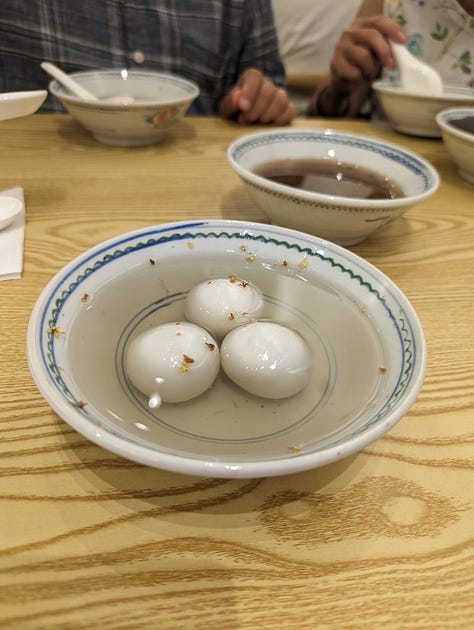
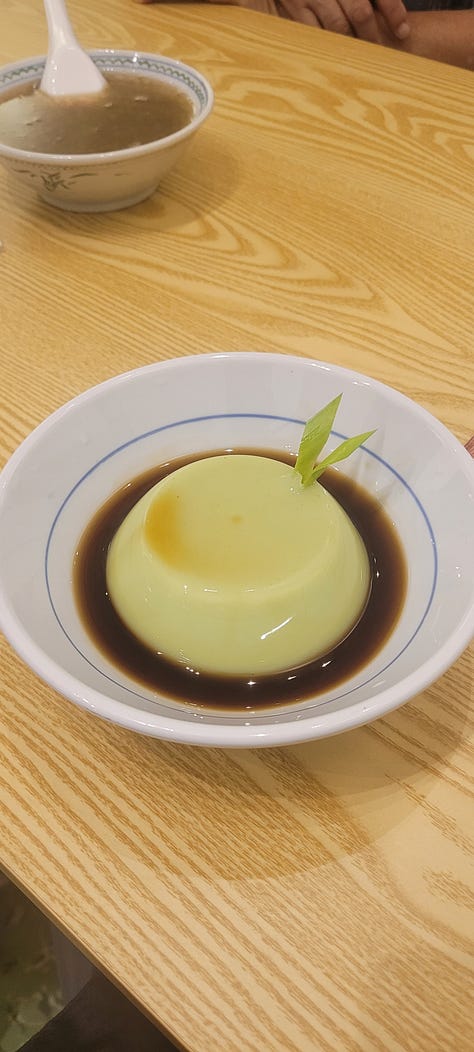
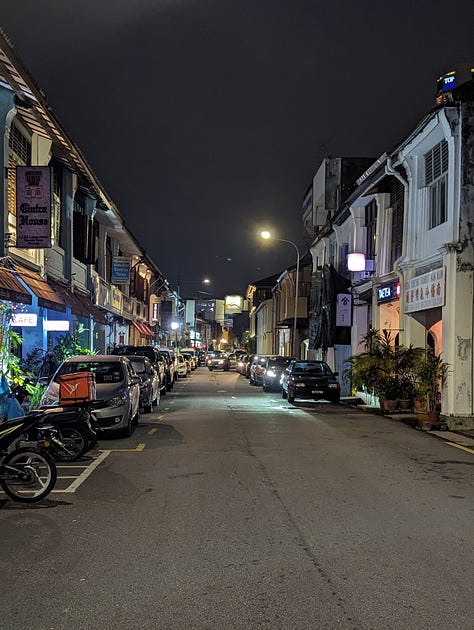
If we generalized the ranking of the Americas, Europe, and Asia by the sweetness of their desserts, it’d probably go like this:
North America »»» South America » Europe » Asia*
*with the exception of Indian desserts
The desserts we had ordered were subtly sweet with its refreshing and gentle flavours. It’s considered a compliment to some Asians if you’re told your dessert isn’t too sweet!
The sweet glutinous rice balls were chewy and filled with a satisfying sweet red bean paste, then surrounded in a beautiful clear sugar-water. On the next plate, the delicate flavour of pandan shone through in the pandan jelly, accompanied with the darker, caramel-y palm syrup. Because the desserts were only lightly sweet, we were able to appreciate the more delicate herbal flavours in each dessert and left feeling light on our feet and in our bellies.
Needless to say, we slept very well that night.
The Eating Continues: Sol’s Sunny Start to the Day
…In fact, Dang-Huy slept a little too well. Baba-nim, Mama-nim, Sol, and Olive-nim were up bright and early, hoping to search for their necessary dose of morning caffeine. Despite all their efforts to shake him awake, nothing could wake Dang-Huy who was deep in a food hibernation - though he woke up for just a lazy second to wave them away to the cafe they wanted to visit.
Dang-Huy: I couldn’t wake up. My belly was too happy from the prior day of eating.
We walked less than two minutes down to the street to a charming little cafe with outdoor-only seating. We all enjoyed our drinks and easy morning chats. From Baba-nim’s chats with the cafe owner that the owner had actually studied as a patisserie in Paris!

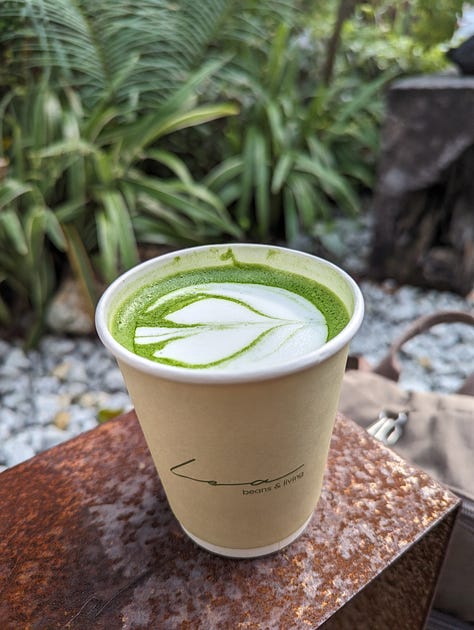
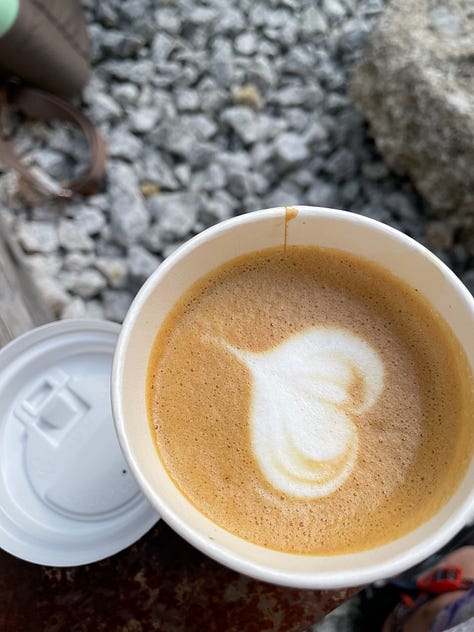
By the time everyone arrived back to the Air-BnB, Dang-Huy had awoken and seemed excited to get the day started. That’s because today was Chicken Day - Hainanese Chicken Day, that is! Being his, and Baba-nim’s, favorite dish, he had put a solid hour of research into finding the best in the city by parsing through dozens of shops via Google Maps, reading through reviews and critically studying the pictures.
Dang-Huy: What is Hainanese Chicken, you ask? I’m glad you asked, because it’s the best food ever created. In summary, it’s a chicken and rice dish originating from an Chinese Island called Hainan. Hainanese immigrants came to Malaysia, Thailand, Vietnam, Cambodia and Singapore looking for economic opportunity, and adapted a delicacy called Wenchang Chicken to use local ingredients. The one we love most is the Malaysian/Singaporean kind. The leaner, more flavourful chickens of Asia are butchered then boiled until the skin is velvety and slippery and the meat is juicy and tender. Excess bits of fat are rendered to extract life-giving chicken fat, which is then used alongside the stock made by boiling the chicken to cook an ultra-flavourful chicken-infused rice. Finally, the chicken meat is served with a sweet and savoury soy sauce alongside refreshing cucumber, the chicken stock, the chicken-infused rice, and green onion. It’s such a simple dish in theory, but the individual components come together in a harmonious, sum-is-greater-than-the-parts celebration of all things chicken.
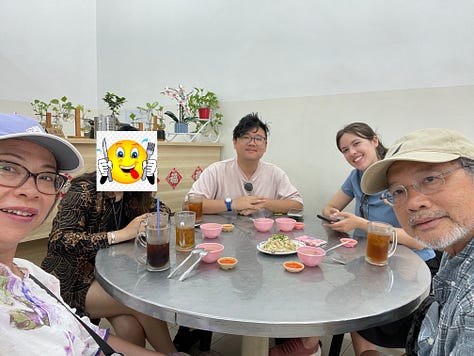
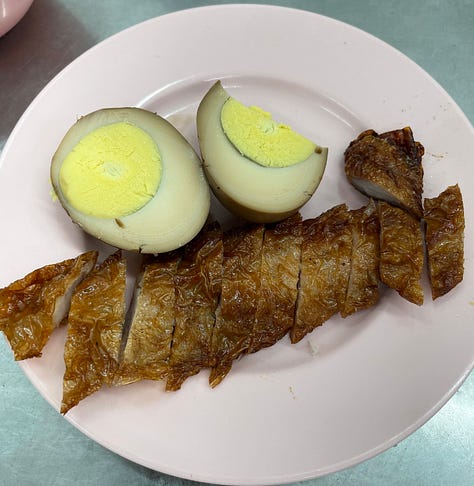
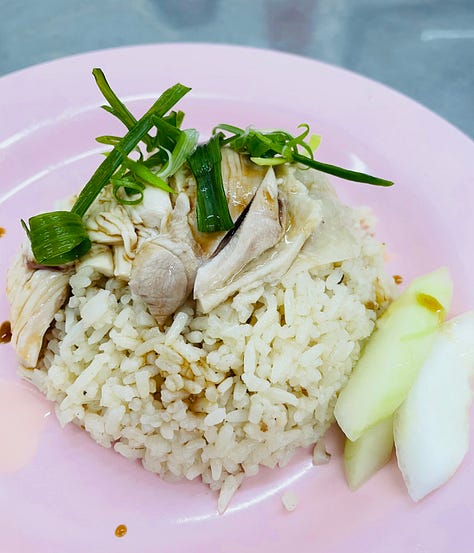
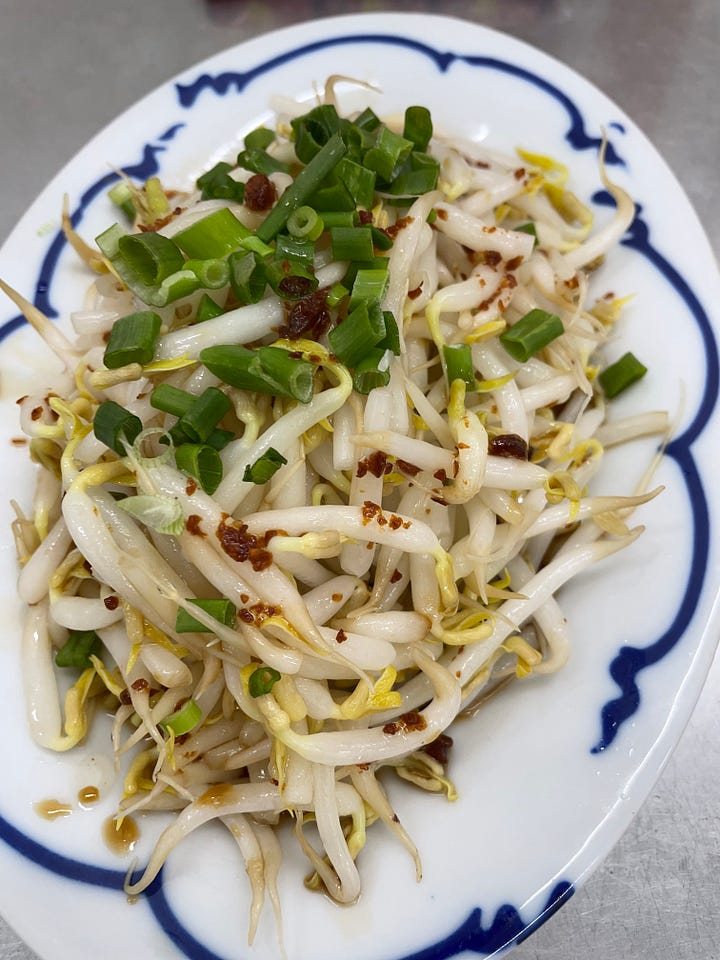
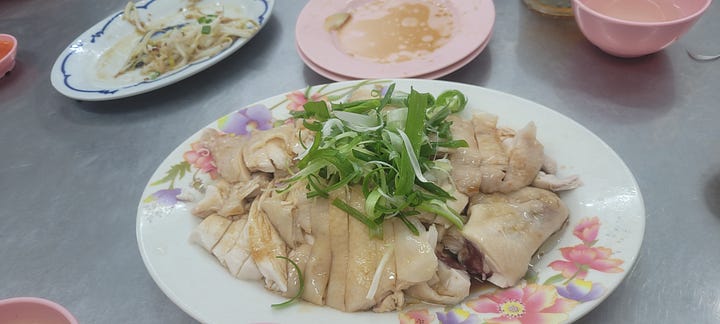
We first ordered four plates of chicken rice and a side of tea eggs, fried fish cake, and bean sprouts tossed in chili peppers, green onions, and soy sauce. First, the complimentary chicken stock arrived, then a small plate of the glorious rice with just a few pieces of the chicken on top.
“No, this will not do”, we said, and promptly ordered an entire platter of chicken after scarfing down our servings instantly. The second order of chicken was even more magnificent. Somehow, the chicken was just so addictive and aromatic. We finished the platter in a flash as well.
As for the sides, the tea egg was a hard-boiled egg that had been marinated in tea and soy sauce, giving it an herbal and salty flavour that made us reach for rice. The fish cakes were tender and smooth, and the bean sprouts served as a crunchy, textural contrast to lighten all the protein we were gobbling down.
While the rest of us ate, Sol simply had to sit and watch us as there was nothing she could confidently eat. So after the rest of us had had our fill of Hainanese chicken, Mama-nim, Dang-Huy, and Sol rushed to find a spot for her to eat at.
Local Vegetarian Food, Temples, and Street Art
Being a well-prepared traveler, Sol used her pre-saved list of local vegetarian restaurants to find a place not too far away. With her hunger growing stronger with every step, time was of the essence! Thankfully, a local vegetarian buffet shop was just a few blocks away.
Upon arriving, it was time to do one of the hardest tasks there is while traveling - navigate a completely new restaurant situation while being a socially anxious person. Here’s our how-to report:
Step 1: Observe what the other patrons are doing. Our research suggested that you grab a plate for dine-in and a box for take-away, then choose what you want from the buffet bar. All other stands appear to be a la carte.
Step 2: Use your peripheral vision to check out the cash register. What is the general price and how is it estimated? From a sample size of two patrons, Sol determined that the weight of the plate was the definitive factor in price.
Step 3: Send your friends to save you a seat. With Dang-Huy deployed off on this mission, Sol flashed her signature “thank you for your service” smile and grabbed a utensil placed strategically next to the register.
Step 4: Eat!
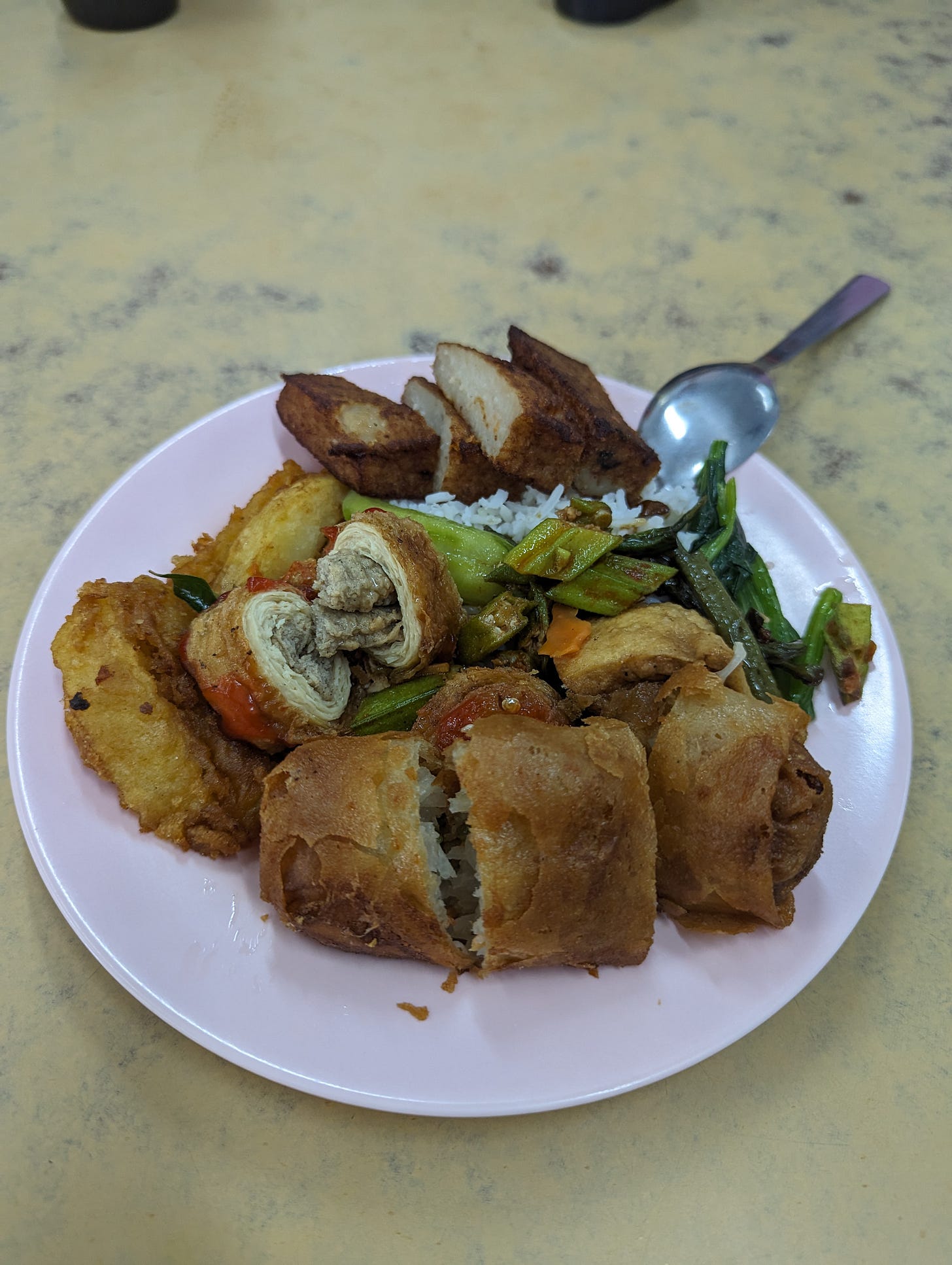
Sol: Everything tasted delicious! It was at room-temperature which is not my favorite way to eat rice or spring rolls, but I was so happy to be able to eat some good local food. We were the only tourists in the shop! Mama-nim was very generous and got us a drink as well, making the meal extra refreshing as the Malaysian heat was in full action. I also have a distinct memory of using the bathroom at this shop and struggling so much. It was a squat toilet, which I was able to use just fine, but there was no lighting or ventilation inside so I couldn’t see a thing but could smell everything. After that experience, I told myself that I was prepared for any restroom to come, which would hold true until four months down the road…
Afterwards, we were ready to do some sightseeing. As the heavy sun beat down on us, we walked around the city en route to the city docks. It was oppressively hot, so much so that we took out umbrellas and used it as shade. It’s quite common in South-East Asia to do this; many do it to protect their skin and prevent tanning, and most do it because it can be many degrees cooler under the umbrella.
As we walked, we passed by an incredible shrine with the most ornate stone carveries and murals.
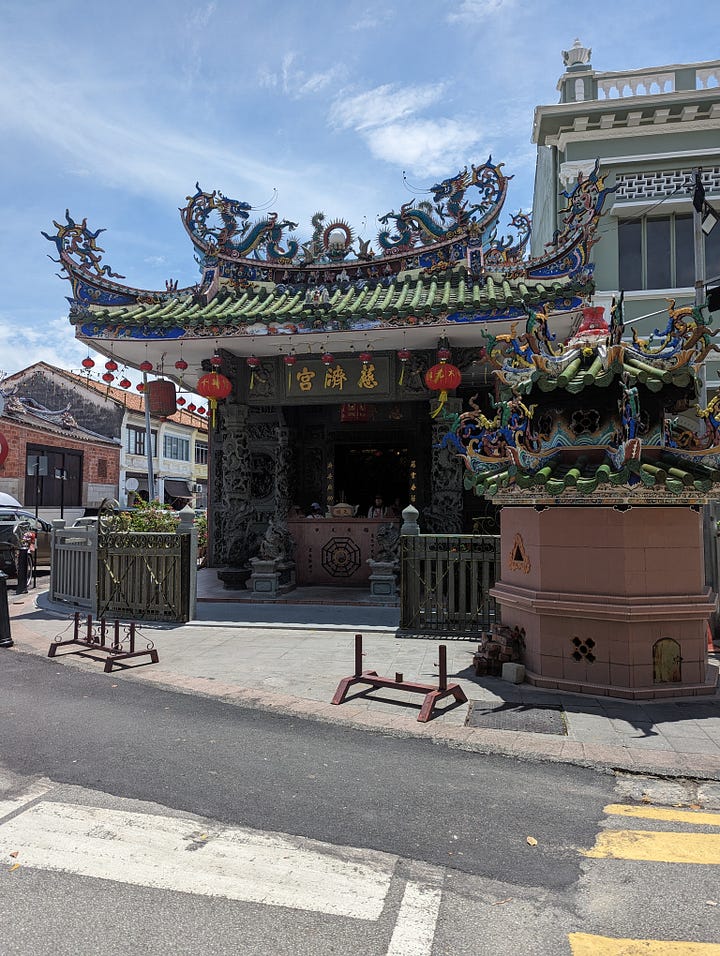
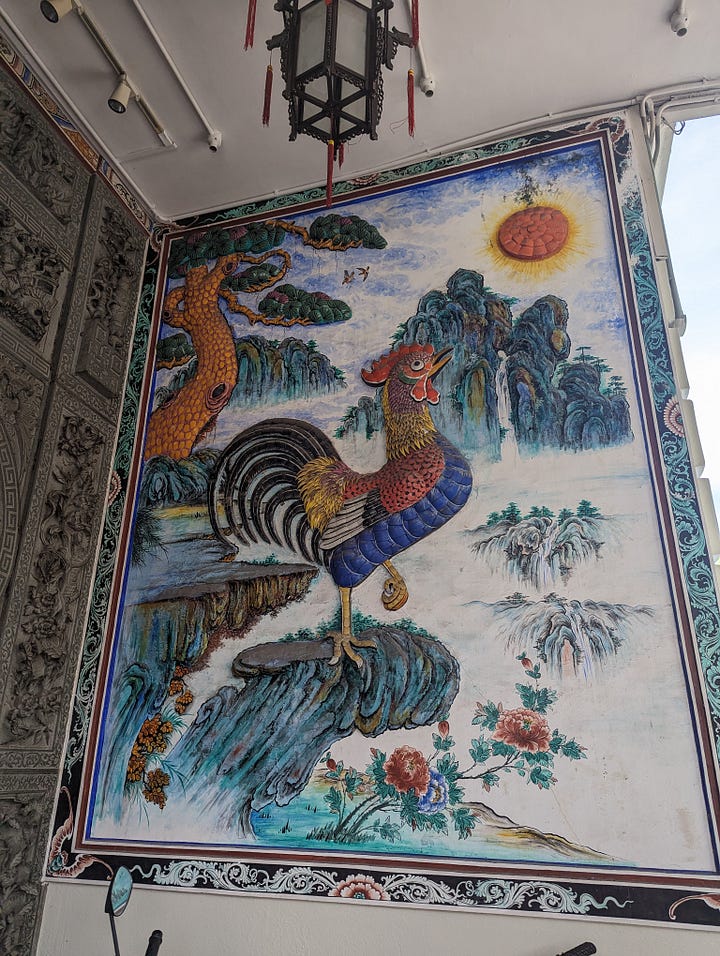
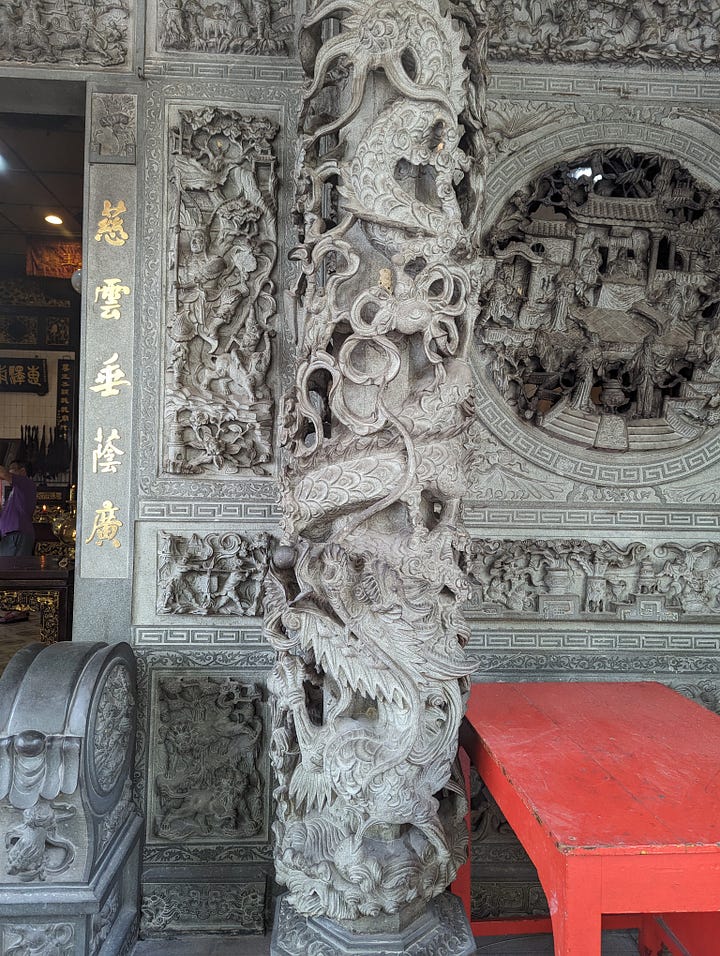
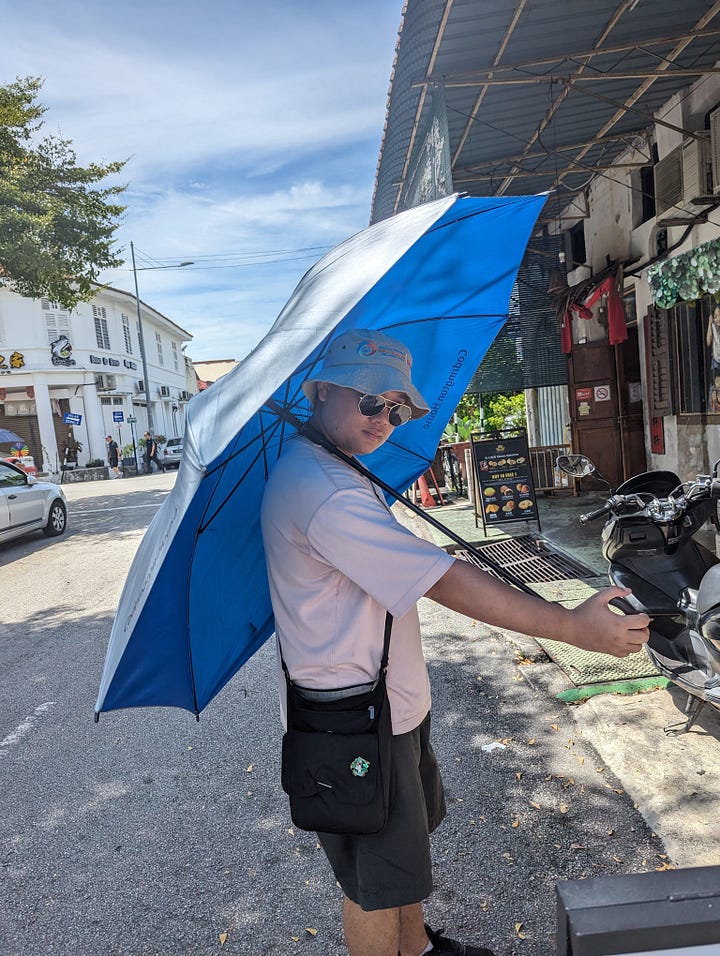
As we continued on, we started noticing street art, some tucked away in alleyways and others hidden in plain sight. Some had plaques nearby giving context on the artists and their works.
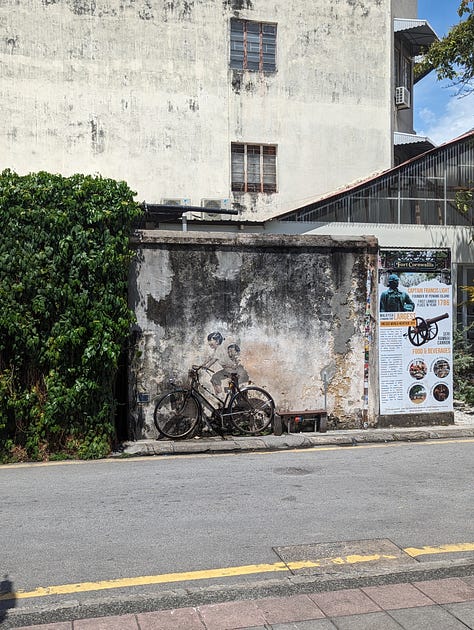
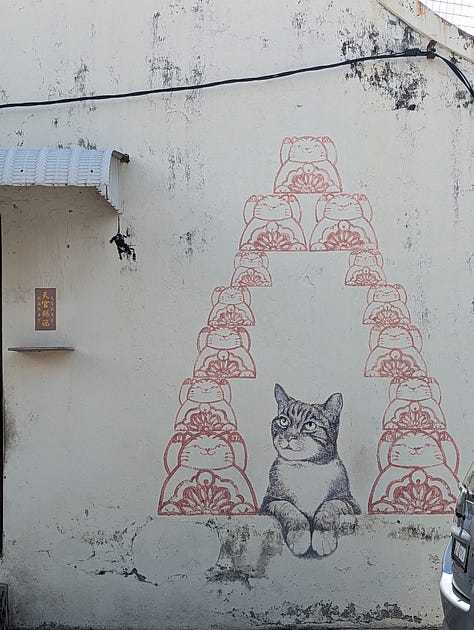
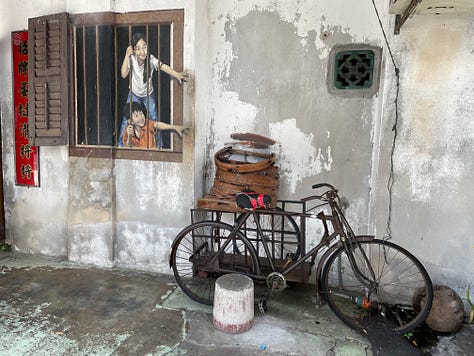
Dang-Huy: The third picture above, of the children behind iron bars reaching for food, stood out to me. Why are they smiling so much if they are trapped behind bars? Is it to reflect the resilience of children?
Sol: I interpreted it a different way. Some countries have bars on the windows to prevent intruders and in the artwork, I see two children having shenanigans as they try to steal some snacks from a local vendor outside.
Continuing on, we marveled in the Sino-Portuguese architecture. Weathered building facades stained with dirt allowed the underlying ornate structures to appear approachable and humble; lush shrubs of greenery burst out of well-loved ceramic pots, evidence of a local’s hard work. Modern, quaint clothing stores splashed a coat of new paint into the interiors of dilapidated merchant homes.
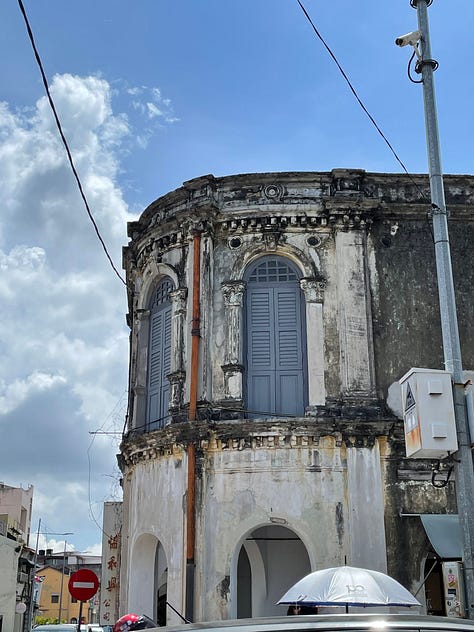
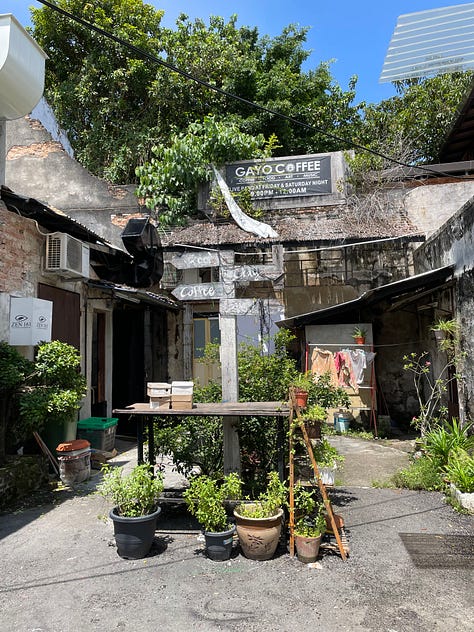
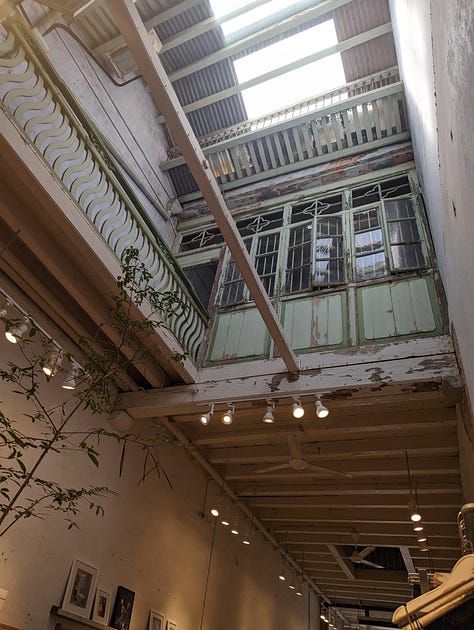
Exploring the Chew Jetty
After a long walk, we finally arrived at the Chew Jetty of Georgetown - a harbor and neighborhood in one! All the homes were built and raised on wooden stilts above the water by Chinese immigrants. What a way to carve out a new home for yourself! The jetty is named after one of the clans who lived in the Chew Jetty (and still do). You guessed it - their last name is Chew.
Nowadays, the jetty’s main paths have become very touristy - stuffed to the brim with trinkets to buy and snacks - but if you just turn down one of the other paths, you can sneak a glimpse into a more normal life of the residents.
Sol: I took this short video to remember the feeling of the jetty. I really enjoyed being able to see a place so different from my own life back in the US and appreciated the sense of community I felt amongst the locals there. I also can’t remember what I was referring to “long noses” in the video. Maybe some type of fish or bird?
Dang-Huy: I felt a sense of bittersweetness when walking through here. It’s great that the tourist business is bringing money to the neighbourhood - I’m sure the original ancestor immigrants would be happy - but if I were a local here I’d probably be tired of all the tourists on my turf.
Walking through, we saw humble, small homes, often with shrines inside, and to be honest it didn’t smell too great. The water was murky and we wondered how the sewage systems worked or if there even was one. There was also a very cool shrine built around a tree at the entrance!
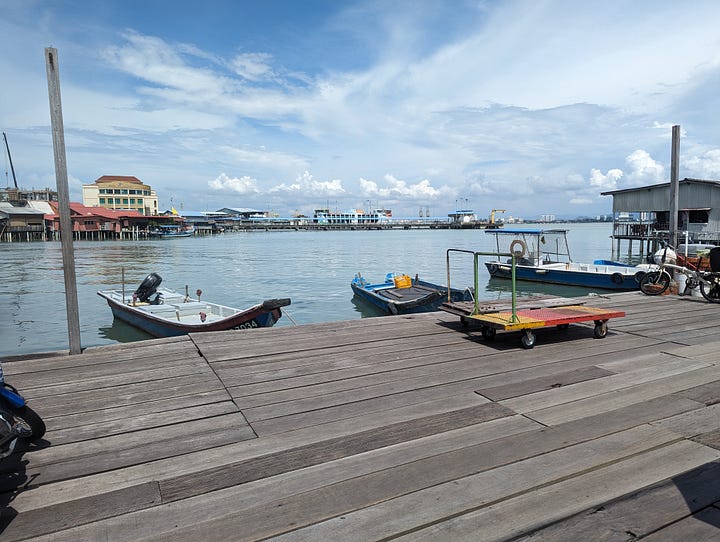
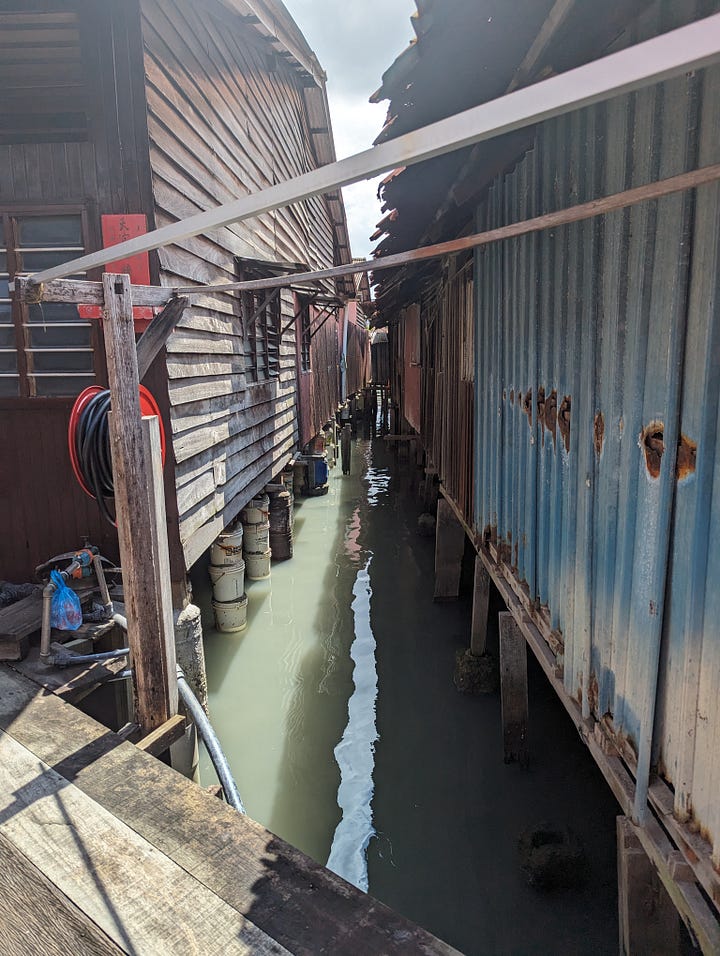
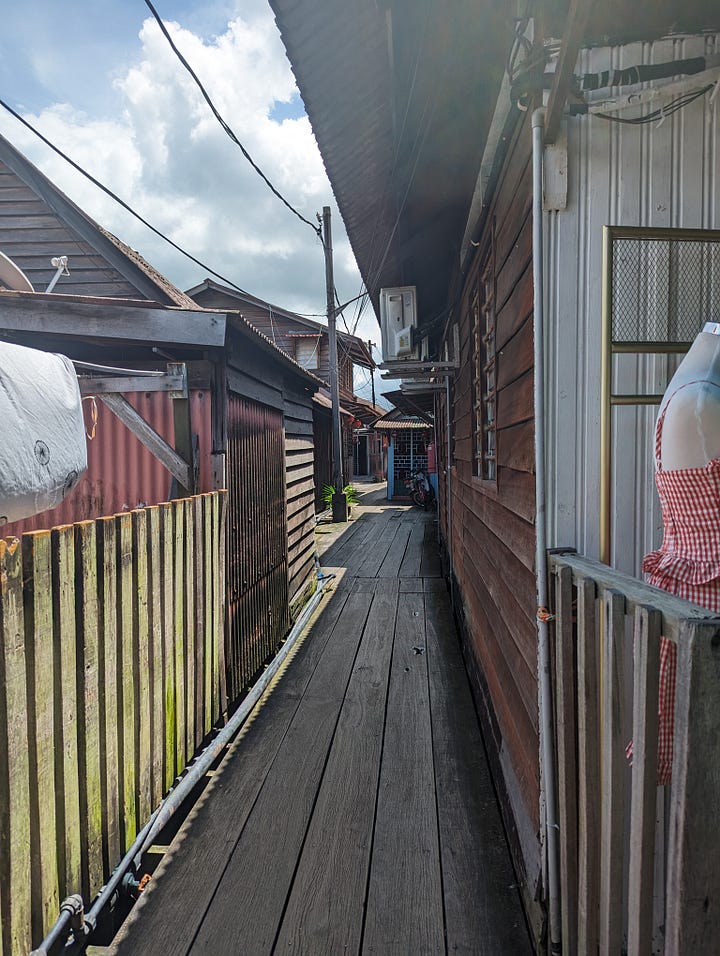
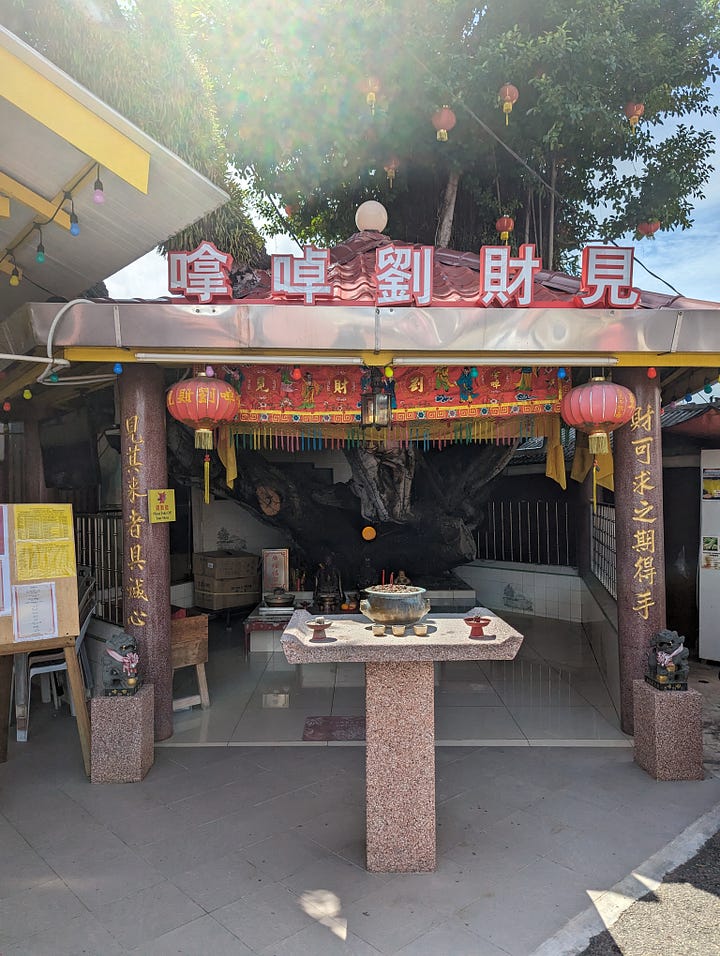
Final Thoughts
So far, our family was infatuated with Penang - it was hitting all of our soft spots for food, architecture, walkability, and tourist sights! On the next newsletter, we’re finishing up Penang with a spin - we’ll have a blast taking photoshoots at a museum, hit the streets for indulgently greasy street foods, sit down at a nice Peranakan restaurant, unwillingly attending an unexpected and somewhat violent Daoist parade, and wrap up at an unsuspecting non-alcoholic drink bar with no menu.
Already planning our return to Penang,
Dang-Huy and Sol





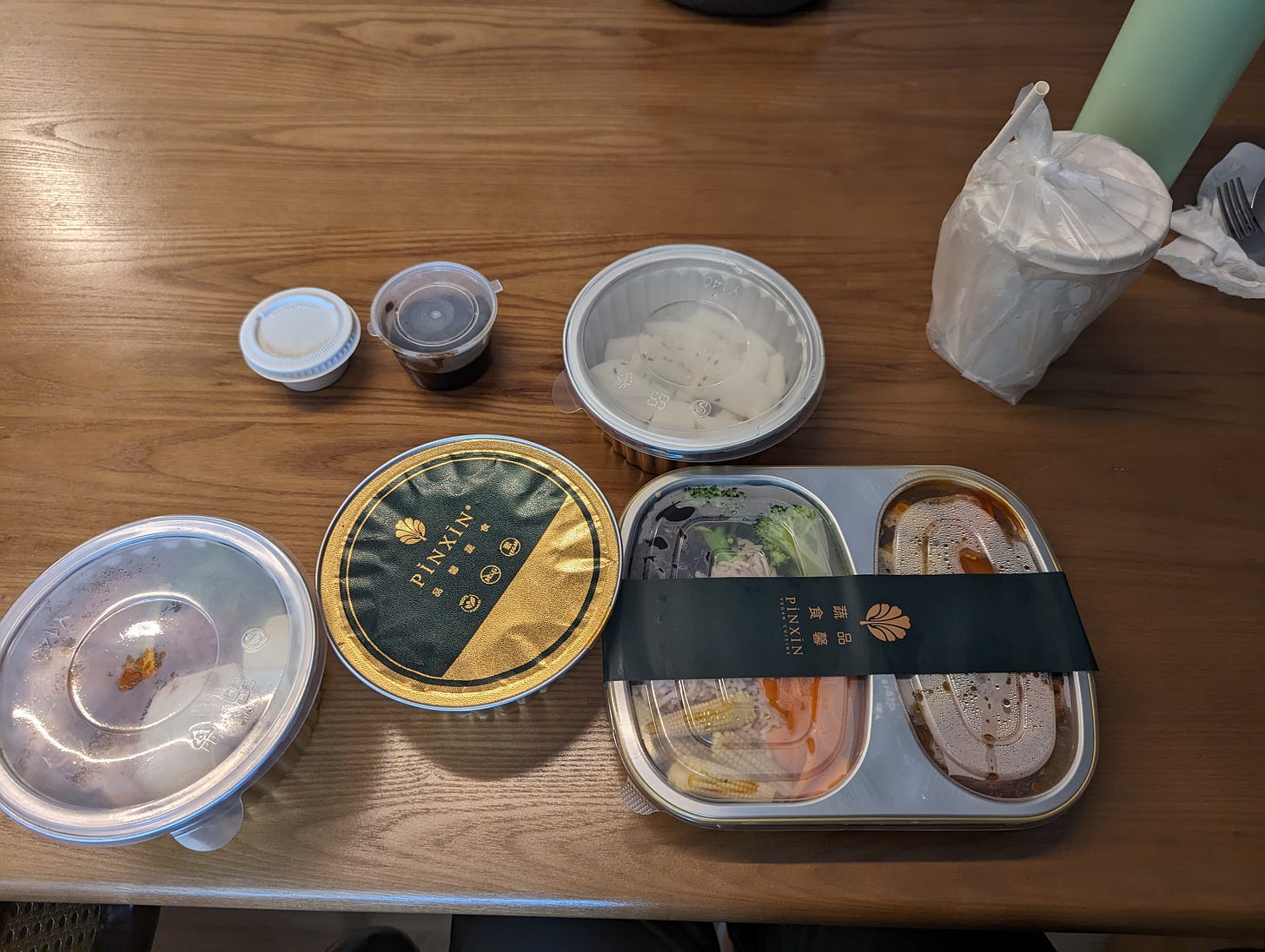


Dear Dang and Sol,
You two are on such a marvelous adventure. Thank you so much for taking the time to write it all down. I can't wait to see where you'll be, foods you'll eat, the city you'll explore when you check in next. Keep going!
~Janet